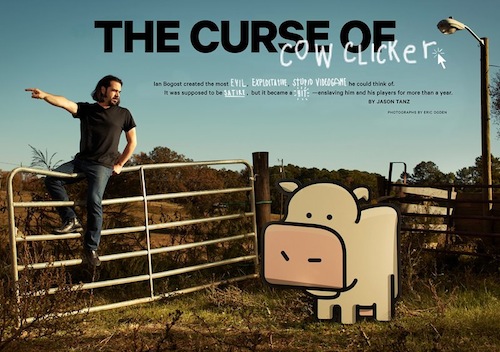
“Hi Ian,” writes one. “I’ve noticed that the Cowpocalypse has happened and users have to pay to see their cow. Do you have a goal or timeframe of when this will be set back to normal?”
“There’s no way to pay to see your cow,” replied the designer. “The cows got raptured.”
I’ve written about Ian Bogost before, and recently two excellent articles recapping the history of his Cow Clicker Facebook game crossed by desk (via Marco).
The Life-Changing $20 Rightward-Facing Cow
Bogost’s years of research and writing on how games could affect perspective and behavior prized design wisdom and a deep understanding of context and of other media. Yet suddenly there was an explosion of investment in gamification startups eager to tack game mechanics onto things like check-in apps. The intersection of games and real life was suddenly a very trendy thing, and a new legion of spokespeople emerged to simplify, systematize and mass-market it.
The Curse of Cow Clicker: How a Cheeky Satire Became a Videogame Hit
To some industry stalwarts, the gamification craze looks a lot like Cow Clicker—mindlessly deploying gaming’s most superficial and addictive features, such as leaderboards and badges, without providing the underlying experience that gives them meaning. Bogost himself made this argument at a gamification conference, during a talk called Gamification Is Bullshit, in which he suggested an alternate term, exploitationware. That, he said, represents the true mission of gamifiers: to use game mechanics to cynically ensnare their customers, much as Cow Clicker had unwittingly hooked its prey—including, as it turned out, Bogost himself.
…both are worth the time to read, especially if you’re even moderately interested in games and social software, or even just social psychology.